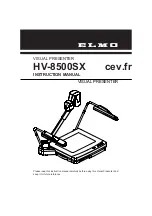
version 1.5 rev 4 Dec 2019
28
Sona &
Marana
1. Light (photons) hits the sensor and generates charge (electrons).
2. The photo-generated charge is converted to an analog voltage for each pixel amplifier.
3. These pixel voltages are transferred to the column bus via a row select signal.
4. The analog voltages are then converted to digital signals via columns of analog to digital (A/D) converters.
5. The final digitized signals are then read out sequentially at a pixel readout speed of up to 200 MHz.
sCMOS sensors provide benefits over more traditional CCD sensors in terms of speed and sensor size, making them
ideal for many scientific applications. The latest sensors, such as that of the Sona and Marana also now provide low
noise, and very high quantum efficiency (QE) through use of a back-illuminated design. Please refer to the Andor website
for a range of technical articles on sCMOS.
4.4.2 e
xtended
d
ynaMic
R
ange
(edR)
Sona and Marana provide an exceptional dynamic range on account of the combination of low noise floor and high
signal handling provided by the large well depth capacity.
Dynamic Range = well depth/noise floor
A dual amplifier architecture is utilised to enable both low noise, and maximum well depth to be used simultaneously.
This delivers a very high linearity of >99.7% across this range allowing for quantitative analyses. When combined with
the high frame rates and large sensor area this provides a lot of flexibility for how the camera may be used.
For dynamic images
- Use 16-bit mode to provide the data range required to capture full range images. Frame rates
will be lower than for 12-bit- however you can use Region of Interest (ROIs) to boost frame rates.
For the fastest frame rates
- Use 12-bit mode for applications in which time resolution is the most critical parameter.
12-bit mode allows frame rates 2 times faster than 16-bit mode at the expense of a reduced dynamic range. ROIs can
also be used to further increase frame rates.
Max Frame Rate (fps)
Marana and Sona 4.2B-11
Sona 2.0B-11 model
ROI Size (W x H)
16-bit
12-bit
16-bit
12-bit
2048 x 2048
24
48
-
-
1608 x 1608
30
61
-
-
1400 x 1400
35
70
35
70
1200 x 1200
41
81
41
81
1024 x 1024
48
95
48
95
512 x 512
95
190
95
190
256 x 256
190
378
190
378
128 x 128
378
750
378
750
2048 x 8
5415
9747
-
-
1200 x 8
5415
9747
5415
9747
2048 x 2
16244
24367
-
-
2048 x 1
24367
24367
-
-
Another consideration is data storage. High frame rate, full frame images at 16-bit can quickly generate many gigabytes
worth of data. Using 12-bit, smaller ROIs or frames rates can help to reduce the amount of image data produced.
















































